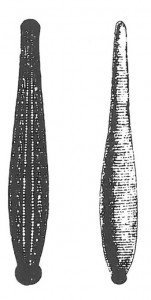
Leeches, Hirudinea, are a kind of segmented worms. There are several species in Denmark. In the hind part there is a suction cup and the leeches we come into contact with during bathing / dabbling in fresh water can suck on to your skin. This normally does not cause any problems unless of course it concerns gnathobdellids, which in Denmark are represented by medicinal leeches and horse leeches, among others.
Medicinal leeches, Hirudo medicinalis, can get up to 15 cm long. The dorsal side is green-black with red longitudinal stripes. It sucks the blood of mammals, frogs, fish, snails, etc. The bite is Y-shaped. It is not felt when the medicinal leech is biting and sucking. The sucking leech can be removed by hand when it is detected. The blood continues to flow out of the wound, but after a while the anticoagulant saliva from the leech has flushed out and the wound closes by itself. The medicinal leech is rare in Denmark. It forms small, local populations, on Bornholm and Zealand, among other places.
The horse leech, Haemopis sanguisuga is somewhat smaller than the medicinal leech and lacks the longitudinal red stripes on the back. It overpowers small animals which it can swallow. While they are being swallowed they are processed by the teeth. As the horse leech is not a bloodsucker it cannot suck the blood of humans. However, large and hungry horse leeches may rasp a Y-shape to the skin. Horse leeches can be found in nearly every waterhole and in most lakes and ponds.




